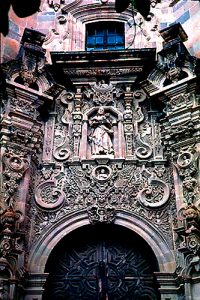 The San Cayetano church was built near the opening to the La Valenciana mine. It overlooks the city of Guanajuato from a hill beside the road to Dolores Hidalgo.
The San Cayetano church was built near the opening to the La Valenciana mine. It overlooks the city of Guanajuato from a hill beside the road to Dolores Hidalgo.
The church is one of the finest of colonial churches in the Churrigueresque Style. This Baroque art form, unique to Mexico, merged the Spanish artistic style with the abundant gold of the country.
The church is filled with several paintings and floor-to-ceiling carvings in white cedar covered with 18-karat gold leaf.
The church is built of cantera, a pink volcanic stone which was carved into intricate altarpieces around the entrances. The irregular shaped atrium in front is encircled by a wall topped by merlons.
Andres de la Riva was the architect of San Cayetano church. Its master carpenter was Manuel Antonio de Cardenas. However, neither lived to see the completion of the church. Jorge Archundia became the new architect, and Jose Simon Cayetano the new master carpenter.
Construction of the San Cayetano church began in 1775 funded by the earnings from the mine. The building was sponsored by mine owner Antonio de Ordenez y Alcocer who had a history of going broke on failed mines. But he reopened La Valenciana in 1760.
La Valenciana was first worked in 1558. It was abandoned the following year when it was considered to have been exhausted. However, the largest silver vein in Mexico was found in this mine, at a depth of 80 metres. The discovery was recorded by Baron von Humboldt who was studying mining operations in the area in the late 18th century.
For discovery of the silver vein King Carlos III bestowed Antonio de Ordenez y Alcocer with the title of Count of Valenciana and Viscount of the Mine in 1780,
The church was built to give thanks to his patron saint St. Cajetan (San Cayetano).
With the intent of founding a monastery the count’s family built a house for monks of the Theatine order, but it was never occupied as a monastery.
